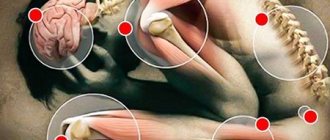The temperature has remained at just over 37°C for several weeks. Wait to swallow antipyretics or worse, antibiotics. Perhaps the reasons for this condition are psychological.
Our expert is a leading researcher in the laboratory of pathology of the autonomic nervous system of the Research Institute of Neurology of the Research Center of the First Moscow State Medical University. I. M. Sechenova, Doctor of Medical Sciences Elena Akarachkova :
For a prolonged increase in temperature against the background of emotional problems, there is a special term - thermoneurosis. Neurologists are involved in its correction. However, before this diagnosis is confirmed, the patient will have to go a long way, and must first contact a therapist.
On a note
Prolonged fever is often experienced by:
Women during menopause . Hormonal changes cause an imbalance in the autonomic nervous system, and at this time women are prone to depression and anxiety.
Lovers of strength exercises . After heavy exercise, lactic acid is produced in the muscles. If there is a lot of it, tissue metabolism is disrupted, which leads to a local increase in temperature. In a healthy person it does not last long. But, if there are problems with autonomic regulation, overtraining can become a provoking factor that will lead to long-term low-grade fever.
Sensitive children .
The situation when a child goes to school after the holidays, and a few days later his temperature suddenly rises, is quite common. Involvement in the educational process is stress, due to which the autonomic nervous system fails. Source
Causes
The impetus for the development of thermoneurosis can be a previous illness, stress, physical and emotional overload, or previous head injuries. It is important to understand that thermoneurosis, the symptoms and treatment of which are largely similar to VSD, is, in fact, a temperature of a neurogenic nature.
People of a neurotic type, with a weak nervous system, are more susceptible to this disease. Today, this diagnosis is not uncommon, since the overall stress load on a person has increased significantly. Teenagers face this even more often - due to increased emotional vulnerability during puberty.
How to treat hypothalamic syndrome, how to get rid of hypothalamic syndrome!
Comprehensive differentiated treatment of patients with hypothalamic syndrome with the widespread use of effective techniques allows one to achieve good results even with severe symptoms.
At the first consultation, the doctor will tell you about the main factors and symptoms of the disease: what is hypothalamic syndrome in newborns, children, adolescents, adults (men and women), what is mild, moderate, severe hypothalamic pubertal juvenile neuroendocrine syndrome (neuroendocrine form) How the army, Wikipedia and obesity are related to hypothalamic syndrome.
Sign up for a consultation. There are contraindications. Specialist consultation is required. Photo: Dgm007 | Dreamstime.com\Dreamstock.ru. The people depicted in the photo are models, do not suffer from the diseases described and/or all similarities are excluded.
Related posts:
Incontinence, treatment of incontinence in Saratov, Russia, symptoms, signs, causes, types
Occipital neuralgia: symptoms, treatment in Saratov
Neuroses, neurosis, treatment of neurosis, neurasthenia, how to treat
Panic, panic attacks: treatment, symptoms, causes, how to fight, get rid of
Neuralgia and neuritis, intercostal neuralgia: symptoms, treatment in Saratov
Comments ()
What is hypothalamic syndrome?
Hypothalamic syndrome is a symptom complex of damage to the hypothalamic region, characterized by autonomic, endocrine, metabolic and trophic disorders.
Various stressful situations, psychotraumatic effects, intoxication, traumatic brain injuries, vascular diseases, tumors, acute infections (influenza, ARVI (ARI), pneumonia, viral neuroinfections), chronic infections (cholecystitis, sinusitis, tonsillitis) play a significant role in the occurrence of hypothalamic syndrome. , rheumatism, tuberculosis). Increased vascular permeability of the hypothalamus can facilitate the penetration of toxins and viruses from the blood into the brain, and displacement of cerebrospinal fluid during traumatic brain injury can cause hypothalamic dysfunction. The occurrence of hypothalamic syndrome is also facilitated by hereditary and acquired constitutional defects of the hypothalamus and closely related structures of the limbic-reticular complex (limbic system and reticular formation) and the pituitary gland. Often, the pathological course of pregnancy and childbirth can be one of the factors of improper formation and maturation of the hypothalamus at various stages of fetal ontogenesis.
Increased body temperature in children and approaches to its correction
Normal body temperature ranges from 35.8oC to 37.4oC [1]. Physiology of thermoregulation Thermoregulation ensures the maintenance of a constant temperature of the “core” of heat, which conventionally includes internal organs. The skin and subcutaneous fat form a “shell” of heat. Skeletal muscles occupy an intermediate position between them. The boundary between the “shell” and the “core” changes depending on environmental conditions and physical activity: with an increase in external temperature and humidity (or physical activity), the boundaries of the “core” expand and narrow at the “shell”; on the contrary, it occurs when the ambient temperature decreases and muscle work is limited [1]. There are two main phases of thermoregulation: chemical and physical. The chemical phase provides heat production due to changes in general and local metabolism, the physical phase provides heat transfer through heat conduction (conduction), heat radiation (radiation), convection (heat transfer from the skin to the air in contact with it) and evaporation of water from the surface of the skin and mucous membranes. The main role is played by sweating and vasomotor mechanisms [1–3]. The coordination of heat production and heat transfer is ensured by the so-called “thermoregulation center”. It is located in the medial preoptic area of the anterior hypothalamus and is mainly responsible for heat transfer - the “thermal center”. The ventro- and dorsomedial nuclei of the posterior hypothalamus (“cold center”) are largely responsible for heat production. The neurons of both of these centers form a thermosensitive area - a thermostat, sensitive to both central and peripheral temperature changes, which senses the temperature of the blood flowing through the vessels of the brain. In addition to the hypothalamus, thermosensitive centers of the brain include the hippocampus, amygdala, mesencephalic activating system, and cerebral cortex [2, 3]. Information from the thermostat is transmitted to the “set point”, which is represented by a conglomerate of neurons in the preoptic area of the anterior hypothalamus and determines the optimal body temperature for the body at a particular moment, when the activity of thermoregulatory mechanisms is minimal. Impacts that change the temperature regime of the body lead to the activation of either the processes of heat production or heat transfer, which contributes to the return of temperature to the original “set point” [2, 3]. Mediators involved in thermoregulation processes are norepinephrine, serotonin, acetylcholine, prostaglandins; the concentration of calcium and sodium ions, adrenocorticotropic and thyroid-stimulating hormones play a significant role [1–3]. Body temperature in children has its own characteristics, which is due to the limitation of heat transfer processes through evaporation, the relationship between surface area and body weight, and the intensity of metabolic processes. Thus, the level of heat production per 1 kg of body weight in children is 5 times higher than in adults, and there is a high risk of overheating when the ambient temperature rises [1]. Body temperature depends on a large number of factors, the most significant of which are: 1. ambient temperature; 2. quantitative and qualitative characteristics of clothing; 3. level of physical activity; 4. age; 5. emotional status; 6. nutritional features; 7. menstrual cycle [1]. In addition, attention should be paid to the presence of acute or chronic somatic diseases (especially infectious, endocrine), autonomic homeostasis, gender, climatic and geographical features of residence, the development of subcutaneous fat (excessive or insufficient) [1]. Disturbance of heat exchange Disturbance of thermal balance leads to the development of hypo- or hyperthermic states. Hyperthermic conditions include hyperthermia itself, heat and sunstroke, hyperthermic reactions and fever [4, 5]. Hyperthermia is a typical form of heat exchange disorder, resulting, as a rule, from high ambient temperatures and impaired heat transfer (Fig. 1). The external reason for the development of this condition is high environmental temperature (hot weather, being in a bathhouse, during fires, in industrial conditions, etc.). In this case, the decrease in heat transfer will depend on both internal (disorders of thermoregulation of hypothalamic origin, obesity) and external (thick waterproof clothing, high air humidity) reasons. Aggravating factors may include intense muscular work, childhood or old age, a number of diseases (hypertension, hyperthyroidism, vegetative-vascular dystonia, obesity, etc.), uncoupling of oxidative phosphorylation processes in mitochondria by exogenous substances (calcium preparations, dicumarol, oligomycin, antipsychotics, etc.) and endogenous (progesterone, catecholamines, thyroid hormones, higher fatty acids, mitochondrial thermogenins) substances [2–5]. A type of hyperthermia is heatstroke - an acute form of hyperthermia with the achievement of life-threatening body temperature values within a short time. This condition develops under the influence of high-intensity heat with low efficiency of the body’s adaptation mechanisms to elevated environmental temperatures [4, 5]. In the case of sunstroke, an increase in body temperature is caused by exposure to solar radiation energy and is characterized by simultaneous heating of the superficial and deep tissues of the body with brain damage [4, 5]. A special type of increase in body temperature is hyperthermic reactions. They are based on the predominance of heat production processes over heat transfer while maintaining the mechanisms of thermoregulation [2, 4, 5]. There are endogenous, exogenous and combined hyperthermic reactions (Table 1) [2, 4, 5]. Fever Fever deserves special attention among heat exchange disorders. Fever is a typical pathological process characterized by a temporary increase in body temperature due to dynamic restructuring of the thermoregulation system under the influence of pyrogens [4]. Depending on the ability to influence the thermoregulation center, primary and secondary pyrogens are distinguished: the former lead to the expression of genes encoding the synthesis of the latter, directly changing the functioning of the hypothalamic thermoregulatory structures [1, 3, 4, 6–8]. There are two main groups of primary pyrogens [3, 4, 8]: 1. infectious: • lipopolysaccharides (endotoxins), which have the greatest pyrogenicity and are components of the cell wall of mainly gram-negative microorganisms; • lipoteichoic acid, peptidoglycans and muramyl peptides of gram-positive microorganisms; • exotoxins and viral particles released during microbial functioning; 2. non-infectious: various substances of protein or fatty origin, nucleic acids, nucleoproteins, coming both from the outside (fat emulsions, blood products, vaccines and serums) and those formed in the body itself (with non-infectious inflammation, tumor disintegration, resorption of hematomas, hemolysis, allergic reactions, necrosis of muscles, parenchymal organs, brain, etc.). In this regard, fever of infectious and non-infectious origin can be distinguished. Secondary pyrogens - cytokines - are formed in leukocytes and in a small dose can change the functioning of the thermoregulation center. These include interleukin-1 (IL-1), interleukin-6 (IL-6), tumor necrosis factor α (TNF-α), γ-interferon (γ-IFN). IL-6 is of greatest importance for the occurrence of fever, the production of which depends on the combined effect of IL-1 and TNF-α on leukocytes. It has been proven that mice lacking the IL-6 gene do not develop an increase in body temperature during bacterial infections [3]. In addition, the body has a number of substances that have an antagonistic effect on pyrogens: interleukin-10 (IL-10), arginine vasopressin, melanocyte-stimulating hormone, glucocorticoids. Depending on various conditions, TNF-α may have both pyrogenic and antipyretic properties. Ultimately, the overall interaction of pyrogenic and antipyretic cytokines influences the height and duration of fever [1, 3]. In the first stage of the rise in body temperature (stadium incrimenti), peripherally formed cytokines enter the bloodstream to the brain, pass through the blood-brain barrier, the permeability of which increases during the infectious process, where they affect the hypothalamic centers, leading to the appearance of both neurological symptoms and fever. The production of pyrogens in the central nervous system (CNS) can be caused by neuroinfections or cerebral hemorrhages [3]. In the preoptic zone of the anterior hypothalamus, pyrogenic cytokines bind to the receptors of neurons of the thermoregulatory center, which leads to the activation of membrane-bound phospholipase A2, the release of arachidonic acid, which, under the influence of cyclooxygenase (COX), is metabolized to prostaglandin E2 (Pg E2). Pg E2 activates adenylate cyclase, resulting in the formation of cyclic 3,5-adenosine monophosphate (cAMP). cAMP-dependent protein kinases lead to a decrease in the threshold of excitability of cold receptors. This, in turn, contributes to the fact that normal blood temperature is perceived as lower, impulses from cold-sensitive neurons increase, and in the neurons of the posterior hypothalamus the “set temperature point” increases (Fig. 2) [3, 4, 6–8]. In parallel, a decrease in heat transfer occurs due to a generalized narrowing of the arteries and arterioles of the skin and subcutaneous fat, and contractile and non-contractile thermogenesis is activated. The consequence of this dynamic restructuring of thermoregulation is an increase in body temperature [3, 4, 7, 8]. Clinically, this stage is characterized by pallor and hyperesthesia of the skin, which, due to contraction of the pilomotors, takes on the appearance of a goose bump, chills, trembling, headache, malaise, various types of impaired consciousness and convulsions are possible. The cardiovascular system reacts with the development of tachycardia, while the degree of increase in heart rate is directly proportional to the increase in body temperature, arterial hypertension, and often arrhythmias. The volume of external respiration increases, and due to multidirectional processes: an increase in the frequency of respiratory movements occurs in parallel with a decrease in the depth of breathing and vice versa. The second stage (stadium fastigii) is characterized by a balance between heat production and heat transfer at a level significantly higher than the prefebrile stage. During this period, there is an increase in heat transfer due to an increase in cholinergic effects, vasodilation and increased sweating. Fluctuations in daily body temperature in the second stage lead to the formation of various types of temperature curves [1, 3, 4]: 1. Constant: the range of temperature fluctuations is less than 1oC (inflammatory diseases of the lungs, kidneys, tonsillitis, typhoid fever, etc.). 2. Remitting: daily fluctuations of more than 1oC, without achieving normal parameters (viral infections). 3. Intermittent (laxative): temperature fluctuations can reach 2oC, with short-term normalization and repeated increase (abscesses of various locations, tuberculosis, malaria). 4. Hectic (depleting): repeated increases in body temperature by 2–3oC followed by a sharp decrease (sepsis). Depending on the level of increase in body temperature, fever is divided into: • subfebrile (37–38oC); • febrile (38–39oС); • pyretic (39–41oС); • hyperpyretic (over 41oC). At this stage, the skin is brightly hyperemic, hot to the touch, dry - “pink” fever. In this case, the degree of tachycardia and tachypnea is correlated with the level of increase in body temperature. When heat transfer processes are disrupted due to centralization of blood circulation and vascular spasm, the so-called “white” fever develops. The condition and well-being deteriorate significantly, tachycardia and tachypnea increase, neurological symptoms appear, and the skin becomes pale and cold to the touch. A rapid and inadequate increase in body temperature, accompanied by impaired microcirculation, metabolic disorders, and dysfunction of vital organs, forms the basis of hyperthermic syndrome [9, 11]. Termination of the action of the primary pyrogen leads to a decrease in the formation of leukocyte cytokines and, accordingly, a decrease in the “set point”. As a result, the third stage of fever (stadium decrementi) develops [1, 3, 4]. With the lytic variety, body temperature decreases gradually, with the critical variety - quickly [1, 4]. Fever has both positive and negative effects. An increase in body temperature can provide a direct bacteriostatic or bactericidal effect by coagulating microbial proteins and reducing their activity. In addition, the phagocytic activity of polymorphonuclear leukocytes, the transformation of lymphocytes and interferonogenesis increases [1, 4, 8–11]. However, with fever, a direct damaging effect of high temperature on the body is also possible, consisting in coagulation of its own proteins, lipid peroxidation, disruption of electrogenesis, water-salt and acid-base balances, which leads to both functional overload of organs and their systems, and the development of various pathological processes in them, especially in children and elderly patients [1, 3, 4, 8–11]. Tactics for managing a febrile patient Based on the positive and negative effects of fever on the body, the question arises about the need to reduce elevated body temperature. First of all, it is necessary to determine the cause of the increase in body temperature - conduct a thorough clinical and anamnestic examination of the patient with elevated body temperature, a differential analysis between fever and hyperthermic reactions (Table 2) [12]. Disorders of thermoregulation of central origin require neurological examination and treatment, and the first diagnostic criterion is the absence of effect from antipyretic drugs. Initially, amidopyrine, metamizole or acetylsalicylic acid were used for this, but due to the high toxicity of these drugs, a test with Nurofen was proposed [2, 7]. In the case of hyperthermia and hyperthermic reactions, the main therapeutic method is to stop the cause of the condition and eliminate risk factors. For this purpose, methods are used aimed at normalizing heat transfer: eliminating exposure to external high temperatures (go to the shade, a cooler place), getting rid of thick, waterproof clothing, using physical cooling methods (wiping with a sponge soaked in cold water, cold compresses or a bath, bubble with ice on the area of large vessels, increasing air circulation using a fan to release heat by convection). In the case of fever, the degree of fever is not an indicator of a bacterial infection requiring antibiotic therapy. Recommendations of the Italian Society of Pediatrics to exclude bacterial infection in febrile children include age of the child less than 3 months, leukocytosis, increased C-reactive protein (level of evidence III, class of recommendation E) [13]. In the Russian clinical guidelines, the indications for in-depth examination are [10]: 1. fever without visible symptoms of a source of infection; 2. fever in a child under 3 months. life; 3. hemorrhagic rash against the background of fever; 4. fever accompanied by abdominal pain and vomiting; 5. stiff neck or soreness due to fever; 6. fever and joint pain; 7. duration of fever more than 2 weeks. Fever, due to the fact that it is an adaptive process with a number of positive effects, is not considered an absolute indication for reducing body temperature. Randomized controlled trials among children with chickenpox showed that the use of paracetamol to reduce body temperature does not improve the condition, but may prolong the disease [14]. The use of antipyretic drugs is necessary [10]: 1. in previously healthy children over 3 months. life: • at a body temperature of more than 39oC and/or; • in the presence of muscle pain or headaches and/or; • in shock. 2. in children under 3 months. life at body temperature more than 38oC; 3. in children with a history of febrile convulsions at a body temperature of more than 38–38.5oC; 4. in children with severe somatic diseases at a body temperature of more than 38.5oC. Due to the difficulties in describing subjective sensations in young children, indications for lowering body temperature may include symptoms such as prolonged crying, irritability, decreased activity, appetite, and sleep disturbances (level of evidence I, class of recommendations B) [13, 15]. Physical cooling during fever is of the least importance as an effective method of reducing body temperature, because Do not affect the main links of the pathogenesis of fever [10, 13, 16]. The absence of the effect of these methods has a high level of evidence [13, 16]. In this regard, the use of drugs with antipyretic property is justified. The choice of a drug to reduce body temperature should be based on the criteria for effectiveness and safety. Over the past 20 years, Ibuprofen (Nurofen) and Acetaminophen (paracetamol) (level of evidence I, the class of recommendations a) [1, 10, 13, 17, 19] have been recognized as such drugs. The action of paracetamol is based on the ability to reduce the level of prostaglandins mainly in the central nervous system, which determines its antipyretical and analgesic effects. A single dose of this drug is 15 mg/kg, repeated use is up to 4 times/day. [1, 10, 11, 13, 17, 18]. Ibuprofen, related to the group of non-steroidal anti-inflammatory drugs, inhibits the activity of the COO-1 and COO-2 not only in the central nervous system, but also in other organs and tissues, which helps to reduce the production of prostaglandins of various classes. In the hypothalamic region, this helps to reduce the heat station. In combination with a decrease in the formation of pyrogenic cytokines in the focus of inflammation under the influence of ibuprofen, its antipyretic effect increases [6, 20]. The pharmacokinetics of ibuprofen is characterized by a rapid achievement and a short period of plasma concentration with biotransformation in the liver using the CYP2C9 isoenzyme and the absence of toxic metabolites. This determines the absence of significant side effects from the liver, gastrointestinal tract, kidneys and cardiovascular system when taking the therapeutic doses of ibuprofen, unlike paracetamol, acetylsalicylic acid, indomethacin and coxibors [6, 20]. When using Ibuprofen’s dosage forms, designed specifically for children (Nurofen suspension for children), no significant side effects were noted even in children with allergic diseases [6, 21, 22]. The greatest clinical effect of ibuprofen is noted after the oral or rectal administration of a single dose of 7-10 mg/kg, although a positive effect is noted after 5 mg/kg [6]. A decrease in body temperature begins in the range from 15 to 40 minutes. With the preservation of the effect for 4-6 hours [6, 13, 20, 23]. E. autoret-leca et al. The article showed the same effectiveness of ibuprofen and paracetamol, but noted that parents prefer to give children ibuprofen [11, 24]. The meta -analysis spent in 2010 Ca Pierce and B. Voss showed iblupen efficiency compared to paracetamol to stop pain and fever [23]. Similar results are reflected in the works of other authors [13, 25]. In this case, an emphasis is on the inappropriateness of the combined administration of these drugs [6, 13, 15]. Ibuprofen is registered in Russia under the original Nurofen®. There are three dosage forms of the drug designed specifically for children: suspension for oral administration (100 mg ibuprofen in 5 ml), rectal suppositories of 60 mg and tablets for children from 6 years old. The dosage form of choice is a suspension as a more physiological path of administration of the drug; Only with repeated vomiting, rectal suppositories are recommended (level of evidence I, the class of recommendations a) [13]. Thus, an increase in body temperature in a child can have a different origin. The diagnosis requires a thorough analysis of clinical-annamic data with the possible use of additional examination methods. The final result of a diagnostic search will be the choice of an adequate method of normalizing body temperature - physical or drug. Among drugs, acetaminophen (paracetamol) and ibuprofen with a preferred technique of the latter are recognized as the most effective and safe.
Literature 1. Studenikin V.M. Clinical aspects of thermoregulation in children // Issues of modern pediatrics. 2003. T. 2, no. 4. pp. 54–60. 2. Autonomic disorders: clinical picture, diagnosis, treatment / Ed. A.M. Veina. M.: Medical Information Agency LLC, 2003. 752 p. 3. Dalal S., Zhukovsky D. Pathophysiology and Management of Fever // J. Support. Oncol. 2006. Vol. 4. P. 009–016. 4. Litvitsky P.F. Pathophysiology: textbook. – 4th ed., rev. and additional M.: GEOTAR-Media, 2009. 496 p. 5. Litvitsky P.F. Disturbance of the body's heat balance: hyperthermia, hyperthermic reactions, heat stroke, sunstroke // Issues of modern pediatrics. 2010. Vol. 9, No. 1. pp. 96–102. 6. Mubarakshina O.A. Relevance of the use of non-steroidal anti-inflammatory drugs for the treatment of fever in children // Issues of modern pediatrics. 2010. T. 9, no. 2. pp. 156–160. 7. Vasechkina L.I. Differential diagnosis of fever of unknown origin // Bulletin of pediatric pharmacology and nutrition. 2007. T. 4, No. 1. P. 46–50. 8. Zaplatnikov A.L. Modern antipyretic drugs in the practice of a pediatrician: issues of effectiveness and safety // RMZh. 2011. T. 19, no. 3. pp. 156–158. 9. Timchenko V.N. Modern approaches to the treatment of fever in children with infectious pathology // Pediatric pharmacology. 2008. T. 5, no. 5. pp. 142–146. 10. Clinical recommendations. Pediatrics / Ed. A.A. Baranova. M.: GEOTAR-Media, 2005. 272 p. 11. Lokshina E.E. Modern view on rational therapy of fever in children // RMZh.. 2013. No. 2. P.103–107. 12. Bonadio WA History and clinical assessment of a febrile child // Russian Bulletin of Perinatology and Pediatrics. 2000. T. 45, No. 5. P. 58 // Pediatric clinics of North America. 1998. Vol. 45: 1. P. 65–76. 13. Chiappini E., Principi N., Longhi R. et al. Management of Fever in Children: Summary of the Italian Pediatric Society Guidelines // Clin. Ther. 2009. Vol. 31, 8. P. 1826–1841. 14. Doran TF, De Angelis C., Baurngardner RF, Melliti ED Acetaminophen: More harm than good for chickenpox? // J. Pediatr. 1989. Vol. 114. P. 145–148. 15. Hay AD, Costelloe C, Redmond NM et al. Paracetamol plus Ibuprofen for the treatment of fever in children (OITCH): Randomised controlled trial // BMJ. 2008. Vol. 337:a1302. doi: 10.1136/bmj.a1302. 16. Meremikwu M., Oyo-Ita A. Physical methods for treating fever in children // Cochrane Database Syst. Rev. 2003. Vol. 2. CD004264. 17. The management of fever in young children with respiratory infections in developing countries – WHO: Geneva, 1993. 18. Barsukova M.V. Some features of the use of antipyretic drugs in children // RMZh. 2012. No. 2. P. 58–63. 19. Studenikin V.M. Non-steroidal anti-inflammatory drugs in pediatric practice // Attending physician. 2011. No. 11. pp. 82–84. 20. Rainsford KD Ibuprofen: pharmacology, efficacy and safety // Inflammopharmacol. 2009. Vol. 17. P. 275–342. 21. Revyakina V.A. Experience of using Nurofen for children with allergic diseases // Issues of modern pediatrics. 2004. T. 3, No. 1. P. 76–78. 22. Geppe N.A. Ibuprofen – place in the tactics of antipyretic therapy in children // Pediatrics. 2013. T. 92, no. 2. pp. 107–111. 23. Pierce CA, Voss B. Efficacy and Safety of Ibuprofen and Acetaminophen in Children and Adults: A Meta-Analysis and Qualitative Review // Ann. Pharmacother. 2010. Vol. 44. P. 489–506. 24. Autret-Leca E., Gibb IA, Goulder MA Ibuprofen versus paracetamol in pediatric fever: objective and subjective findings from a randomized, blinded study. Current Med. Research and Opinion. 2007. Vol. 23, No. 9. R. 2205–2211. 25. Zaitseva O.V. Possibilities of using ibuprofen in the treatment of acute pain in children // Issues of modern pediatrics. 2004. T. 3, no. 4. pp. 41–44.
Sympathoadrenal crisis
Sympathoadrenal crisis in hypothalamic syndrome is manifested by severe headache, pain in the heart, palpitations, a feeling of fear, palpitations, a feeling of fear, difficulty breathing, numbness of the extremities. During a crisis, the skin is pale, dry, blood pressure (BP) is elevated, there may be slight hyperthermia (37.0; 37.1; 37.2; 37.3; 37.4; 37.5; 37.6; 37.8 ; 37.9 degrees Celsius), dilated pupils, increased erythrocyte sedimentation rate (reaction) (ESR, ROE), hyperglycemia (increased blood glucose levels). The attack often ends with chills, frequent urination (pollakiuria) or a single copious discharge of urine (polyuria).
Neurotrophic form
The neurotrophic form includes various trophic disorders due to damage to the hypothalamus: trophic ulcers, focal or diffuse edema of different parts of the body (especially in combination with vegetative-vascular crises), brittle nails, osteoporosis, osteodystrophy, some types of alopecia /hair loss/. In its pure form, the neurotrophic form is rare, and trophic disorders are included in the structure of other forms of hypothalamic syndrome, more often in the neuroendocrine-metabolic form.
Neuromuscular form, catalepsy, narcolepsy | Hypothalamic syndrome
The neuromuscular form is manifested by general weakness, adynamia, and transient atypical attacks of catalepsy. Catalepsy (affective adynamia, emotional asthenia, affective loss of muscle tone, Levenfeld-Enneberg syndrome) is a short-term, paroxysmal loss of muscle tone, which occurs more often with strong emotional influences and leads to the patient falling without loss of consciousness. Catalepsy is a symptom of narcolepsy. Narcolepsy (Gelino's disease) is a disease from the group of hypersomnias, characterized by attacks of irresistible drowsiness and falling asleep during the daytime. Neurologists and neuropathologists distinguish essential narcolepsy, which occurs without visible external influences, and symptomatic narcolepsy, which occurs after infections, epidemic encephalitis, traumatic brain injuries, tumors of the 3rd ventricle, pituitary gland, internal hydrocephalus. Attacks of drowsiness occur suddenly, often in inappropriate conditions: while eating, walking, talking, urinating. The attacks usually last for several minutes. Depending on the external manifestations, neurologists distinguish 2 forms of narcolepsy: monosymptomatic, which is manifested only by attacks of falling asleep, and polysymptomatic, which is manifested by attacks of falling asleep, catalepsy, night sleep disturbances, and hypnogogic hallucinations.
Prevention of rotavirus
Nonspecific prevention includes a set of sanitary and hygienic measures (regular hand washing, using only boiled drinking water, room ventilation, wet cleaning). Another important point is the timely isolation of a sick person who exhibits signs of acute respiratory viral infection and intestinal infection.
Gastroenterologists advise taking prebiotics and probiotics as a preventive measure. Probiotics, called “friendly bacteria,” are live microorganisms that aid digestion and improve protection against possible infections. Natural probiotics are found in fermented milk products: organic yogurt and cheeses, miso soup, sourdough bread, and sauerkraut. There are also probiotic supplements that come in capsules or drinks.










